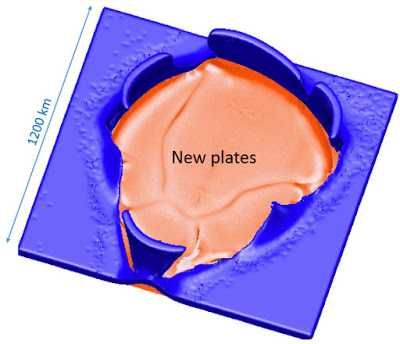
Our planet Earth is the only planet in the Solar System that possesses Plate Tectonics. The Earth’s surface is in a constant state of change; the tectonic plates together with the oceans and continents continuously slide along one another, collide or sink into the Earth’s mantle. However, it still remains unclear how Plate Tectonics started on Earth.
An international research team combining modeling experts from the ETH Zürich, the GFZ German Research Centre for Geosciences, and geologists from the University of Texas and Korea University in Seoul have proposed an answer to this question in a recent publication in the journal Nature. Based on advanced high-resolution numerical modeling and geological observations they demonstrate that a hot mantle plume rising to the lithosphere from the deep mantle might have broken the intact outer shell of the early Earth and induced the first large-scale sinking of lithospheric plates, a key process of Plate Tectonics called subduction.
The rigid outer shell of present-day Earth that includes crust and uppermost mantle, i.e. the lithosphere is divided into several plates. Lithospheric plates slide along their boundaries or colliding with each other and some of them, which are cold and heavy enough, sink into the deep mantle. This process, called subduction is the key process of Plate Tectonics responsible for the recycling of the materials of Earth’s crust into the deep mantle and for an efficient cooling of the Earth interior. However, subduction and Plate Tectonics was not always taking place on Earth. During the first 1 or 2 billion years of the 4.5 billion years Earth’s history, the tectonic process was very different, probably similar to present-day Venus, where the lithosphere is not broken into plates and no subduction occurs. So how did the first subduction and Plate Tectonics develop on Earth?
“Three conditions must have been met for the mantle plume to start first long-lived subduction and Plate Tectonics on Earth”, says Stephan Sobolev, Head of Geodynamic Modeling Section at GFZ and Professor of Geodynamics at University of Potsdam. “First, the mantle plume had to be large and hot enough to produce a lot of melt. These melts intruded into the lithosphere above the plume making it mechanically weak and allowing the plume to penetrate into the crust. Second, the lithosphere had to be thick and heavy enough to sink into the mantle”. In the beginning the broken lithosphere around the plume was probably pushed down by the load of the plume material spreading above it and then the sinking parts of the heavy lithosphere pulled down the adjacent lithosphere. “Finally there had to be liquid water in the ocean to lubricate, in a way, the surface of the sinking lithospheric plate” adds Sobolev. “This allowed it to sink deep into the Earth”.
All these conditions were fulfilled sometime in early Earth history, but were never met for other planets of the Solar System. For instance on Venus, which is most similar to the Earth, hot mantle plumes are probably quite common, but the lithosphere is too hot and light and there is no liquid water at the hot surface of Venus.
It was most likely not just an interaction of a single mantle plume with the early Earth lithosphere, but rather a number of such interactions that were responsible for the triggering of Plate Tectonics on Earth. The vigorous inner life of our unique planet created a number of “plate tectonic windows” as shown in the Figure, which joined after some time and induced global Plate Tectonics.
Reference:
T.V. Gerya , R.J. Stern, M. Baes, S.V. Sobolev and S.A. Whattam, Plate tectonics on the Earth triggered by plume-induced subduction initiation, Nature, 12.11.2015, DOI: 10.1038/nature15752
Note: The above post is reprinted from materials provided by GFZ GeoForschungsZentrum Potsdam, Helmholtz Centre.










